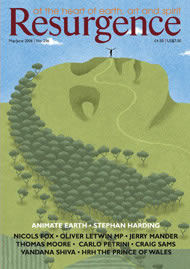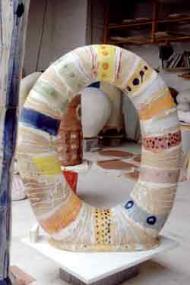READERS OF RESURGENCE will be familiar with Sandy Brown: she has written the crafts column for four years. But what of Sandy’s own work?
For her tableware alone, Sandy is a leading figure in the field of contemporary ceramics. There is no-one quite like her. She throws her pots using very soft clay on a slowly turning wooden kick-wheel and throws such passion into them, such freedom of movement, that they are unmistakably hers. It is her drive and mission to work in a state of play, spontaneously creating forms in one fluent gesture and decorating them with wild, unmediated brushstrokes. “Creativity is play” is her mantra.
Sandy moved on to create small- and large-scale sculptures and often spends thirty minutes a day creating a new sculpture in clay, just enjoying the process; being unprecious with the outcome. Sandy tells me that she always empties her mind at these moments and allows whatever forms to emerge that need to. Yet the results look familiar: they resemble in spirit the clay votives that have been dug up from Palaeolithic sites, the goddess figures from Çatal Höyük and the free sculptures naturally made by children.
For some years now, Sandy has been gestating a major work. I visited her at her gigantic studio in a disused glove factory in Appledore, North Devon one perfectly frosty, clear January day. As I entered into her workshop, I felt as if I had stepped into another world. I was in a dusty sacred grove made of ceramic, with sculptures towering either side of me, symbols of male and female – artworks that I could not explain, but which looked deeply familiar. She said that they were for an artwork called The Dance and that, for her, that was the eternal dance of life.
How can one speak about something that is essentially wordless? Or articulate something which is intended to be intuitive and of the Earth? Sandy is true to her material. The power of clay is that it is of the Earth: heavy, fecund, primordial. This is why we find the votives of Çatal Höyük so compelling. Sandy is not afraid of this. She is content to stay in this realm while she makes her work with clay. To really understand the work you have to stand near the sculptures, to experience their presence, because they are taller than you, with a heavier physical mass. They are overwhelming.
SANDY EXPLAINS THAT when she throws her pots on the wheel she is ritualistic in her processes. Certainly, this comes from her training in Japan, as she vividly remembers how every day was infused with rituals: in the workshop, at mealtimes and with the preparation of food. Living in a different culture from the one you grew up in perhaps sharpens your awareness of the rituals in your own culture when you return.
Before Sandy’s exhibition The Still Point and the Dance, there will be a smaller more domestic-sized event in which Sandy will invite people to take part in her own version of a Japanese tea ceremony. She is making in advance each of the clay utensils, casting a kettle and furnishing the room with textiles she has made herself. In doing so she wants to create a Still Point and reminder of the daily rituals of life that serve and renew us.
The past two years have been spent in a spirit of ambitious experimentation. Sandy felt the need to push the boundaries of scale and so she sought a larger studio to work in and built a big kiln to fire the work. The physical challenges of preparing and sculpting with this volume of clay, on sculptures of this size, have been immense. She is still committed to working with spontaneity, and the gestures have gone from the movement of hands and fingers to the arms and the whole body. Sandy describes this as “drawing in the air”.
Sandy Brown’s exhibition, The Still Point and the Dance, will open in May at The Glove Factory, Appledore and will be open to the public during the Appledore Festival (1st–4th June) and until 24th July. It will then tour internationally.
Shall We Dance? (detail)








